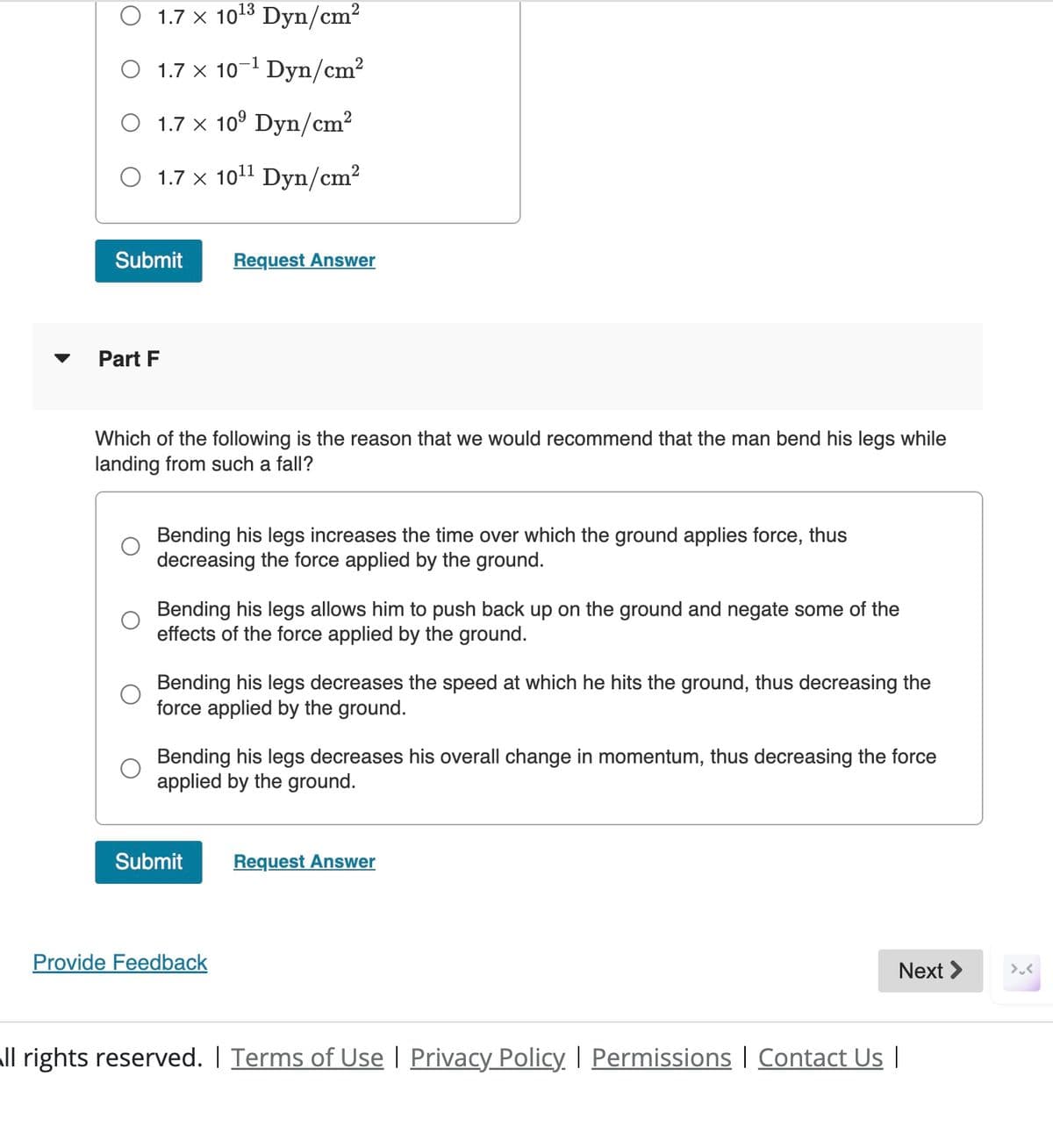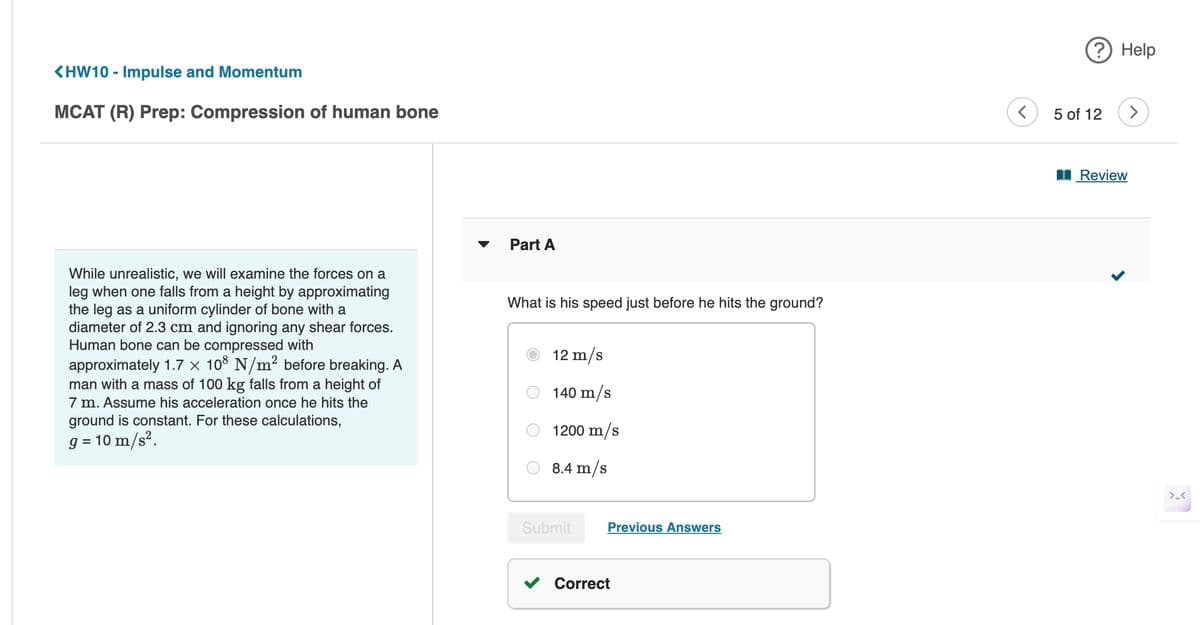13 O 1.7 x 10¹³ Dyn/cm² 1.7 × 10¹ Dyn/cm² O 1.7 x 10⁹ Dyn/cm² O 1.7 x 10¹¹ Dyn/cm² Submit Request Answer Part F Which of the following is the reason that we would recommend that the man bend his legs while landing from such a fall? Bending his legs increases the time over which the ground applies force, thus decreasing the force applied by the ground. Bending his legs allows him to push back up on the ground and negate some of the effects of the force applied by the ground. Bending his legs decreases the speed at which he hits the ground, thus decreasing the force applied by the ground. Bending his legs decreases his overall change in momentum, thus decreasing the force applied by the ground. Submit Request Answer Provide Feedback All rights reserved. | Terms of Use | Privacy Policy | Permissions | Contact Us | Next > >< Review >.<
13 O 1.7 x 10¹³ Dyn/cm² 1.7 × 10¹ Dyn/cm² O 1.7 x 10⁹ Dyn/cm² O 1.7 x 10¹¹ Dyn/cm² Submit Request Answer Part F Which of the following is the reason that we would recommend that the man bend his legs while landing from such a fall? Bending his legs increases the time over which the ground applies force, thus decreasing the force applied by the ground. Bending his legs allows him to push back up on the ground and negate some of the effects of the force applied by the ground. Bending his legs decreases the speed at which he hits the ground, thus decreasing the force applied by the ground. Bending his legs decreases his overall change in momentum, thus decreasing the force applied by the ground. Submit Request Answer Provide Feedback All rights reserved. | Terms of Use | Privacy Policy | Permissions | Contact Us | Next > >< Review >.<
College Physics
11th Edition
ISBN:9781305952300
Author:Raymond A. Serway, Chris Vuille
Publisher:Raymond A. Serway, Chris Vuille
Chapter1: Units, Trigonometry. And Vectors
Section: Chapter Questions
Problem 1CQ: Estimate the order of magnitude of the length, in meters, of each of the following; (a) a mouse, (b)...
Question
answer the question part f in photos, please do correctly, not graded but i only have one chance and this is a paid service that has given me wrong answers before and led to me learning things wrong and getting points off and thats not ok this is paid so please please do corectly

Transcribed Image Text:13
O 1.7 x 10¹³ Dyn/cm²
1.7 × 10¹ Dyn/cm²
O 1.7 x 10⁹ Dyn/cm²
O 1.7 x 10¹¹ Dyn/cm²
Submit
Request Answer
Part F
Which of the following is the reason that we would recommend that the man bend his legs while
landing from such a fall?
Bending his legs increases the time over which the ground applies force, thus
decreasing the force applied by the ground.
Bending his legs allows him to push back up on the ground and negate some of the
effects of the force applied by the ground.
Bending his legs decreases the speed at which he hits the ground, thus decreasing the
force applied by the ground.
Bending his legs decreases his overall change in momentum, thus decreasing the force
applied by the ground.
Submit
Request Answer
Provide Feedback
All rights reserved. | Terms of Use | Privacy Policy | Permissions | Contact Us |
Next >
><

Transcribed Image Text:<HW10 - Impulse and Momentum
MCAT (R) Prep: Compression of human bone
While unrealistic, we will examine the forces on a
leg when one falls from a height by approximating
the leg as a uniform cylinder of bone with a
diameter of 2.3 cm and ignoring any shear forces.
Human bone can be compressed with
approximately 1.7 × 108 N/m² before breaking. A
man with a mass of 100 kg falls from a height of
7 m. Assume his acceleration once he hits the
ground is constant. For these calculations,
10 m/s².
9 =
Part A
What is his speed just before he hits the ground?
12 m/s
140 m/s
1200 m/s
8.4 m/s
Submit
Previous Answers
Correct
? Help
5 of 12
>
Review
>.<
Expert Solution
This question has been solved!
Explore an expertly crafted, step-by-step solution for a thorough understanding of key concepts.
This is a popular solution!
Trending now
This is a popular solution!
Step by step
Solved in 2 steps

Recommended textbooks for you

College Physics
Physics
ISBN:
9781305952300
Author:
Raymond A. Serway, Chris Vuille
Publisher:
Cengage Learning

University Physics (14th Edition)
Physics
ISBN:
9780133969290
Author:
Hugh D. Young, Roger A. Freedman
Publisher:
PEARSON

Introduction To Quantum Mechanics
Physics
ISBN:
9781107189638
Author:
Griffiths, David J., Schroeter, Darrell F.
Publisher:
Cambridge University Press

College Physics
Physics
ISBN:
9781305952300
Author:
Raymond A. Serway, Chris Vuille
Publisher:
Cengage Learning

University Physics (14th Edition)
Physics
ISBN:
9780133969290
Author:
Hugh D. Young, Roger A. Freedman
Publisher:
PEARSON

Introduction To Quantum Mechanics
Physics
ISBN:
9781107189638
Author:
Griffiths, David J., Schroeter, Darrell F.
Publisher:
Cambridge University Press

Physics for Scientists and Engineers
Physics
ISBN:
9781337553278
Author:
Raymond A. Serway, John W. Jewett
Publisher:
Cengage Learning

Lecture- Tutorials for Introductory Astronomy
Physics
ISBN:
9780321820464
Author:
Edward E. Prather, Tim P. Slater, Jeff P. Adams, Gina Brissenden
Publisher:
Addison-Wesley

College Physics: A Strategic Approach (4th Editio…
Physics
ISBN:
9780134609034
Author:
Randall D. Knight (Professor Emeritus), Brian Jones, Stuart Field
Publisher:
PEARSON